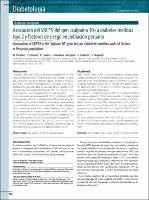| dc.contributor.author | Paredes, M. | |
| dc.contributor.author | Lizaraso, F. | |
| dc.contributor.author | Lissón, R. | |
| dc.contributor.author | Rodríguez, E. Giovanna | |
| dc.contributor.author | Calderón, J. | |
| dc.contributor.author | Huapaya, J. | |
| dc.date.accessioned | 2019-04-24T14:11:00Z | |
| dc.date.available | 2019-04-24T14:11:00Z | |
| dc.date.issued | 2010 | |
| dc.identifier.citation | Avances en Diabetología. 2010;26(3). | es_PE |
| dc.identifier.uri | https://hdl.handle.net/20.500.12959/411 | |
| dc.description.abstract | La diabetes mellitus tipo 2 (DM2) se define genéticamente como una enfermedad compleja originada por la interacción del medio ambiente y los genes, que se encuentran ubicados en diferentes regiones del genoma humano. El gen calpaína 10 (CAPN10), localizado en 2q37.3, constituye un gen de susceptibilidad para esta enfermedad. La asociación alélica y haplotípica observada de los polimorfismos de nucleótido simple (SNP) 19, 43 y 63 en poblaciones amerindias y algunas europeas confirmaría estos resultados. En esta investigación se postuló que los SNP 19, 43 y 63 del gen CAPN10 estaban asociados a DM2 en la población peruana. Se analizaron 45 pacientes diabéticos y 58 familiares no diabéticos. Además de los factores de riesgo como la obesidad, el índice de masa corporal (IMC), la hipertrigliceridemia (HTG), la hipertensión arterial (HTA) y la hipercolesterolemia (HC), se identificaron –mediante reacción en cadena de la polimerasa (PCR)– los SNP 19, 43 y 63 del gen CAPN10. Se analizaron los resultados utilizando las pruebas de equilibrio de Hardy-Weinberg y el análisis de regresión logística condicional. Se observó asociación del SNP19 a DM2. | es_PE |
| dc.description.abstract | Type 2 diabetes mellitus (T2DM) is genetically defined as a complex disease
caused by the interaction of environment and genes, which are located in different regions from the human genome. Calpain 10 (CAPN10) is a susceptibility gene for the disease, located in 2q37.3. The allelic and haplotypic association observed of SNP’s 19, 43 and 63 in Amerindian and some European
populations would confirm these results.
In this research, it has been postulated that SNP’s 19, 43 and 63 of CAPN10
gene were associated with T2DM in Peruvian population. It has been analyzed
45 diabetic patients and 58 non-diabetic relatives. Among other risk factor for
obesity, such body mass index (BMI), hypertriglyceridemia (HTG), arterial hypertension (HTA), and hypercholesterolemia (HC), it has been identified by
polymerase chain reaction (PCR) SNP’s 19, 43 and 63 of CAPN10. The Hardy-Weinberg test and conditional regression logistic were used to analyze the
results.
The results showed association of SNP19 with T2DM (χ
2= 8.31; p= 0.01)
and BMI, HTG, HC in Peruvian diabetic families. The main contribution of this
research is having detected these associations in the diabetic Peruvian population. | |
| dc.format | application/pdf | es_PE |
| dc.language.iso | spa | es_PE |
| dc.publisher | Sociedad Española de Diabetes | es_PE |
| dc.relation.uri | https://medes.com/publication/60860 | |
| dc.rights | info:eu-repo/semantics/openAccess | es_PE |
| dc.rights.uri | https://creativecommons.org/licenses/by-nc-nd/4.0/ | es_PE |
| dc.source | Seguro Social de Salud (EsSalud) | es_PE |
| dc.source | Repositorio Institucional EsSalud | es_PE |
| dc.subject | Endocrinología y Metabolismo | es_PE |
| dc.subject | Diabetes Mellitus Tipo 2 | es_PE |
| dc.subject | Factores de Riesgo | es_PE |
| dc.subject | Type 2 diabetes mellitus | |
| dc.subject | Calpain 10 | |
| dc.subject | SNP19 | |
| dc.subject | Peruvian population | |
| dc.title | Asociación del SNP19 del gen calpaína 10 a diabetes mellitus tipo 2 y factores de riesgo en población peruana | es_PE |
| dc.title.alternative | Association of SNP19 in the “calpain 10” gene to type 2 diabetes mellitus and risk factors
in Peruvian population | |
| dc.type | info:eu-repo/semantics/article | es_PE |
| dc.subject.ocde | https://purl.org/pe-repo/ocde/ford#3.05.00 | es_PE |
| dc.publisher.country | PE | es_PE |






